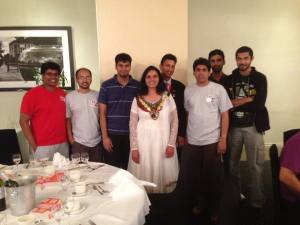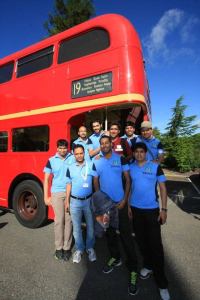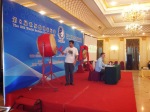On Day 3, we had the individual round results displayed. I finished 23rd, which was an improvement on last year’s 24th by a single rank. At this point I remembered that there was a special prize for 22nd place at the 22nd World Puzzle Championship last year in Beijing. I wondered if that had become an annual thing and made a mental note to ask Alan. I hoped that no one would knock me down to last year’s rank. A small part of me also hoped I wouldn’t climb so I could claim that 23rd place prize if it existed, since there aren’t any big differences between 22 and 23.
Anyway, up next was a single team round, before the top 10 competed in the individual playoffs. This was a unique team round, with three phases and the third phase being a team playoff of sorts. The round was built around a puzzle which required formation of squares using some constraints moving counters and using knight moves from chess. It was a fun, easy round, but the first 7 puzzles were only the first part, or the first two phases. The third phase was for the top 8 scorers of the first two phases.
Round 15 – Square Bashing (TEAM) (Part I) (30 minutes) – 2040/1800. 7/7 solved.
Rohan is great at chess, and I’m good with moving pieces, so we complemented each other well, and with assistance from the other two team-mates we finished the 7 puzzles in good time. Not good enough to be top 8, but a solid enough finish to the WPC for Team India. The biggest reason this was a perfect team round though, is obviously the fact that my team didn’t have to deal with my handwriting for once.
The team finished 15th. Considering we missed the 2014 Indian Puzzle Champion, Amit Sowani, this was a good enough result. Jayant Ameta was a debutant and got some welcome experience. Hopefully he improves in the coming years so we have more depth in the team.
Anyway, the next part is purely from a spectator’s point of view… for the most part, anyway.
Round 15 – Square Bashing (TEAM) (Part II) (45 minutes) (2800 points for first finisher)
This round was more physical than other rounds. Teams running and jumping around on boards is probably not what you’d expect to see at a World Puzzle Championship so this was fun. Basically, the humans were the movable counters and the floor was the grid. All 4 team members stood on different starting points and there were numerous rounds of forming a square, reaching another starting point, and forming another square. The rules were quite strict and any wrong step that is submitted to the real-time judging personnel would result in a disqualification. Unfortunately, this is what happened to Team Japan, who ended up with 0 points. Otherwise, as far as I can remember, all other teams managed to finish the round fine, though I don’t remember rankings and scores.
After the round was officially done, some of the spectators, myself included, decided to try the puzzle out ourselves in seemingly random groups of four. Our huge advantage was that we’d seen that one of the squares formed took up all four corners of the grid, and another took up just a 2×2 area of cells. Even so, since we were playing for fun, we put that away. For some reason I played twice, I guess because there was a group with just 3 people in it and needed a volunteer to play it once.
WPC Playoffs –
Unlike the WSC playoffs, I attended these. Japan had three solvers in the top 10, and Germany were close to having three as well, but Roland Voigt just missed out with an 11th place. The playoffs were divided into three parts. The first part was between solvers ranked 7-10. Here, Kota raced ahead even though he started after 2 players, coming into it at 9th and ending up 7th. He advanced to the next part, which would be between the solvers ranked 4-7. Here, Palmer Mebane started ahead of the other three and finished ahead of the other three, to reach the final stage.
The final stage had Ulrich Voigt (Germany) starting around 2 and a half minutes before Endo Ken (Japan), 3 minutes before Florian Kirch (Germany) and 4 and something minutes before Palmer Mebane. In the second puzzle itself, Endo hit a roadblock and just couldn’t make things work, allowing both Florian and Palmer to jump ahead. He kinda sorta recovered and was catching up until the 5th puzzle (or maybe the 4th, there’s no list on the Instruction booklet so I can’t be sure) where he hit a roadblock again which took him out of the running altogether. Ulrich and Florian were both moving along steadily (or, well, blitzing through at unbelievable pace, but steadily by their standards I guess), but Palmer was having a great time of it here. He had two amazing solves in there, including (and my memory is foggy here on the details) an Unequal Length Maze in 20 or so seconds. At the end, Ulrich managed to hold fort, but Palmer finished 22 seconds after Ulrich, a much lesser margin than the staggered start of 4 minutes would indicate. But Ulrich is, deservedly, the 2014 World Puzzle Champion, making it 3 in a row. Ulrich is a 10 time World Puzzle Champion with this victory, but this was the first time he has a series of 3 in a row, so he’s stronger than ever right now. Florian finished at 3rd, holding steady with the rank he started the playoffs at. Endo had a bit of a fall, but thankfully due to the categorized playoffs, he still has an impressive 4th place to show for it. Congratulations once again to all the winners.
So that ended the WPC, and after that we had the traditional game of football. This time, I didn’t break anything! I also literally let out a celebratory yell right after the game stating that I didn’t break anything! This is a big deal after last year. I think. Anyway…
That night we had the closing ceremony. Here’s the big official list of award winners. I was obviously waiting for my nice little unofficial award. I had, by then, talked to Alan O’Donnell, one of the lead organizers, about the existence of the award for Xth place at the Xth WPC. Turns out that this award was around this year too, and since this is the only year where I could improve my ranking (23rd from 24th) and still win this award, I’m happy to get it. From the next year I can target better ranks in peace. This was all part of the plan… is what I’ll claim from now. Anyway, here’s the Mayor of Croydon presenting the medal –
Incidentally, she is originally from India and settled in the UK. She requested to meet the Indian team as well. After a pleasant conversation, we had a photo taken.
After the ceremony and dinner, we had the usual Karaoke night. Other than the fact that the World Sudoku Champion Kota Morinishi (Japan) gave a great solo performance AND stuck around for a duet with David Jones of Canada (how epic would a Champion duet have been? Should’ve asked Ulrich to stay on), we did manage to uphold the tradition we started last year of multiple countries’ participants getting together for Wonderwall…
As always, I stayed up until my departure time and slept on the way to the airport and also while waiting for the flight. So that’s it for the recaps.
Just to summarize India’s rankings (only the A teams),
World Sudoku Championship –
India A – 6th (New Indian record for best team performance).
Individuals –
Rohan Rao – 14th. Myself – 21st. Rishi Puri – 36th. Sumit Bothra – 55th.
World Puzzle Championship –
India A – 15th.
Individuals –
Myself – 23rd (New Indian record for best individual performance). Rohan Rao – 36th. Swaroop Guggilam – 48th. Jayant Ameta – 90th.
To end these recaps officially, here’s the full Indian team. The front row: myself, Deb Mohanty (WSC team captain), Kunal Verma (WSC B team), Jaipal Reddy (WSC & WPC B team). The back row: Jayant Ameta (Also WSC B team in addition to WPC A team mentioned above), Rohan Rao (WPC team captain), Rishi Puri, Swaroop Guggilam (WSC B as well) and Sumit Bothra.






 .
.


